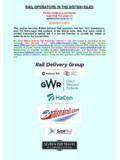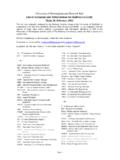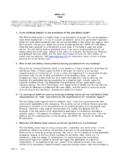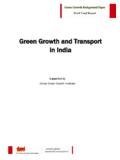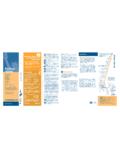Transcription of Ensuring a Sustainable Rail Industry
1 A Sustainable rail IndustryOptions for developing franchised passenger servicesContentsExecutive summary 31 Franchising: A model that has revolutionised the rail Industry The rail Industry has seen a period of sustained and unexpected growth This growth has changed the role of the railway in the UK Growth means that train companies today look very different to 1998 The franchising model has struggled to keep up with these changes 112 Franchising: A model facing a period of turbulence The franchise model may appear to be ..but passengers might disagree A slowdown in growth would be critical for the franchise model However, the franchise model may be compounding the .. means the Industry is not able to work together to address the .. and may not support a holistic approach to demand management. 233 A single network facing different challenges A network of different customers with different requirements A network making different use of its core infrastructure A network which needs different things from stations and trains A network facing different competitive pressures A network serving different stakeholders A network at different stages of development 344 Improving the effectiveness of the current franchising approach The Role of Franchises within the current Industry structure Theme One: Changing the variable from finance to quality Theme Two: Changing the evaluation process Theme Three: Creating a fairer financial structure for the Industry Theme Four.
2 Create a better alignment of risks for the franchise model 415 A long-term evolution of the franchising model A new role for operators in the National rail and broader transport network Building a new set of franchise models to innovate the rail Industry Creating a new market for train operations Ensuring an integrated network operation Ensuring an affordable railway 486 Next steps: moving towards a more Sustainable model 49 Appendix Exemplar models for train operating companies 5123 Executive summaryThe franchise model developed for the UK passenger rail network was created at a time of stagnant revenue and falling passenger demand. It was intended to reduce the burden of the network on government finances However, events of the past twenty years show that the rail network has followed a rather different trajectory, with improved external conditions and revived commercial management stimulating unprecedented a result, the franchises themselves have changed considerably.
3 What was originally 25 franchises all let centrally has become only 20 franchises - 15 let by the DfT. The average turnover of these 15 businesses has more than tripled, from 192m in 1998 to 744m in 2016. Over the same period, the ownership of the operating franchises has changed, whilst the risks of winning and losing a limited number of very large contracts has had profound impacts on the Industry supply growth could be seen as a strong endorsement of a system which has proven to be flexible, adaptable and transformed the finances of the railway. The continued re-letting of franchises, the strong interest international operators have in the UK and the success UK operators have had overseas support , the challenges of improving operating performance and meeting the capacity requirements placed on the network mean that many passengers may not agree. Moreover, the franchising model may be facing a period of significant risk and uncertainty which could ultimately make it unsustainable: Recent bids have been predicated on strong revenue growth.
4 Such ambitious targets may prove challenging for operators especially in the context of a slowdown in the rate of growth in rail demand over the last 18 months. if that does turn out to be the case the economics of the franchises means that the financial implications could be significant. Meanwhile the concentration of the Industry in a small number of very large franchises creates risks for the supply chain. Whether an operator wins or loses any given franchise can have a disproportionate impact of the size of its overall business, making it difficult to ensure a Sustainable investment strategy and plan accordingly. Additionally, it is not clear that the current franchising model is best placed to support the wider development of the rail Industry or reflect its role as a key catalyst of the UK s economy. Specifically: The current franchise model has struggled to create the right mechanism to support investment or encourage decision which are made on the basis of whole life costs.
5 Whilst attempts to address this have been made including through longer franchises these have tended to import too much risk into the franchises themselves and risk creating an unsustainable model The current franchise model has also struggled to deliver optimal solutions for the development of key assets such as stations or support an Industry wide strategy for rolling stock which minimises long term cost and supports innovation. A lack of integration with Network rail both in terms of incentives and planning horizons has also created problemsEXECUTIVE SUMMARY4 There is not a clear link between the current franchise model and the emerging industrial strategy or economic requirements from the railway. The railway is a vital economic asset for the UK s economy and is also a vibrant Industry in its own right with a large and skilled supply chain. The process of awarding, managing and operating franchises needs to reflect this.
6 There are two essential pre-requisites to the effective reform of the franchise model: First, the Government must clarify the economic and financial role of the railway and the appropriate balance between taxpayer and fare payer to fund the railway Second, the DfT must lead a fundemental and bold review of fares to create a new system which removes the absurd complexity of current Industry ticketing whilst Ensuring that core rail products are more closely attuned to the needs of the modern this is achieved, then there are several areas where the franchise system could be improved and made more Sustainable within the current Industry structure. These could be based around four key themes: Changing the variable from finance to quality, asking bidders to offer a proposed service offer within a given affordability envelop rather than specifying requirements and asking bidders for financial quotes Changing the evaluation process, to give quality more weight, consider whole network costs and ensure an evaluation of the economic benefits of proposals.
7 Creating a fairer financial structure for the Industry , to ensure that there is acceptable certainty on future franchise payments, that any windfalls from ambitious bids are retained in the Industry and Ensuring that no franchise becomes too big to fail Creating a better alignment of risks for the franchise model, with a common set of objectives for network development, a consistent view on the nature of competition and greater flexibility to link with the national industrial strategy and longer term changes in travel the longer term, there may be benefits of rethinking the wider structure of rail franchises. A move from a single standardised model to a suite of smaller franchising models may provide much more flexibility in the network. This in turn might bring a greater set of skills into the Industry , ensure the appropriate focus on capacity management and utilisation and provide a more effective way of integrating local rail networks into the local economy.
8 Such changes whilst not without their challenges could offer a new approach to maximising the value and Ensuring the sustainability of the rail SUMMARY51. Franchising: A model that has revolutionised the rail The rail Industry has seen a period of sustained and unexpected growth The franchising model developed in the mid-1990s for the UK passenger rail network was established in the context of a predictable and declining passenger trend. Ridership and revenue were falling and a combination of ever increasing car ownership and the growth of domestic air travel presented limited optimism for growth in passenger numbers or appetite for investment to enhance the railway indeed the focus was on identifying ways to reduce the burden the railway imposed on the economy through a clear focus on cost reduction rather than revenue growth. The twenty years since franchising was introduced have not panned out as anticipated.
9 A combination of strong economic growth and increased road congestion have created a benign environment for the rail network. A change in national and local government policy to promote more Sustainable modes of transport (most notably through the congestion charge in London but also seen through investment in local transport schemes and increases in city centre parking charges in most towns and cities across the UK) have created the foundations to enable strong growth. The innovative pricing, targeted marketing and enhanced customer services delivered by private train companies, coupled with increased Central and Local Government investment in new infrastructure, have capitalised on this environment and driven an unparalleled period of demand for rail growth (Figure 1) and increased rail s role in day to day travel patterns (Figure 2).Figure 1: Passenger rail journeys since 1980 Figure 2: Indexed demand by mode of travel (1980 = 100)SECTION 1 Franchising: A model that has revolutionised the rail This growth has changed the role of the railway in the UKThe growth in passenger numbers and revenue seen in the rail Industry since privatisation has radically changed the place of the railway in the economic infrastructure of the finances of train operators are transformed.
10 From requiring of subsidy in 1998/99, rail operators made a net contribution of over 1bn 2014/15. Intercity operators paid a total premium of c. 600m to the Treasury in 2016, equivalent to of the DfT s total operating budget. Previous analysis by Credo and CBT has suggested that the Industry will pay between and in premia to the Government by 2019/20 (Figure 3).The overall state of Industry finances is more nuanced, due to the cost of maintaining and enhancing the infrastructure and the mechanism by which this cost is divided between the train operators and the Government. The Industry still required of public funding in 2015/16, and with a total of 53bn having been invested by the government since 2000, the ongoing cost of the railway to the tax payer should not be underestimated. That said, franchising has helped to deliver a significant rebalancing of the financial burden for the railway, with farebox revenue contributing 74% of total Industry costs in 2015 usage of and demands on the network have increased considerably.



